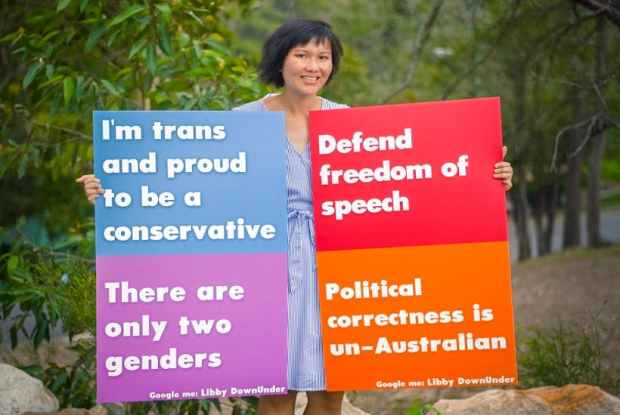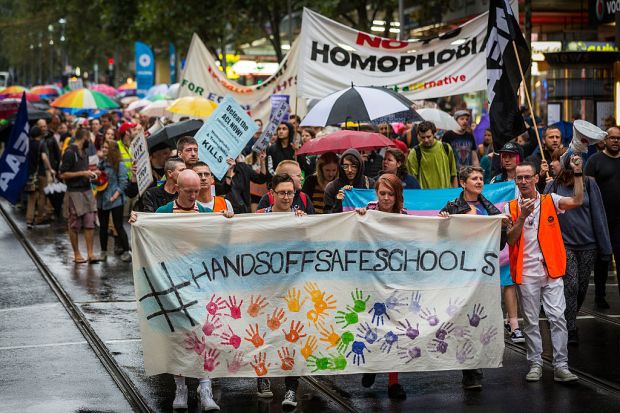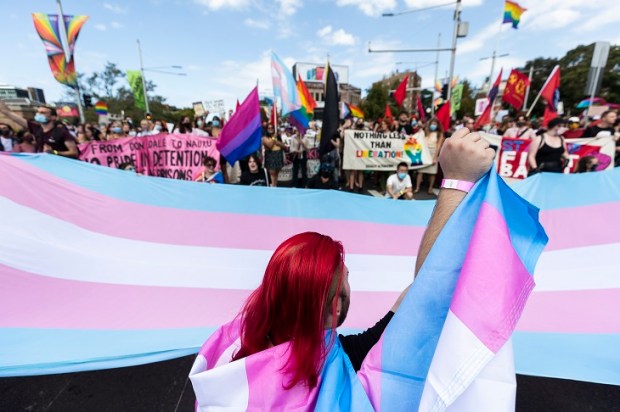A new transgender trainwreck in Australia was announced this week. New guidelines published in the Medical Journal of Australia give the green light for potentially more trans children to go on hormone replacement therapy (HRT) as young as 13, defying international guidelines. Whilst this experiment was hailed as world-leading, the minimum legal age for smoking, drinking and voting in Australia remained at 18, and it’s still 16 for consensual sex, all for good reason. So why 13?
Like similar experiments previously, one of the aims is to reduce the overall transgender suicide rate. 41 per cent of transgender (alleged) people have experienced suicidal ideation or self-harm, though this statistic does not indicate to what extent the attempts were before or after transition, or at what stage of transition. Nevertheless, studies have shown high rates of suicide amongst trans (alleged) people post-medical transition. Why is this the case?
Enter Associate Professor Michelle Telfer, lead author of the new guidelines, who sticks to the neo-Marxist narrative: “transgender children and adolescents experience high rates of stigma and discrimination, bullying, social exclusion and abuse” – only to then acknowledge the “increasing visibility and social acceptance of gender diversity in Australia”. The truth is life is tough on all children and adolescents, in many different ways.
In my experience as a transwoman, and through knowing other trans people in my life, transition surgeries are an answer but not the answer to the long-term health and well-being of gender dysphoria patients. Unfortunately, many trans people get so fixated on surgery for so long, that they may forget that there is more to life than surgery. The fixation is often driven by the fantasy that surgery, and transition in general, will transform them into a new person and that all the problems in life will go away. Of course, they get the surgery, and then they get lost in life, albeit not all do.
As such, the availability of HRT and surgery isn’t the issue; the issue is that there are trans adults, let alone impressionable children, not taking a holistic and forward-thinking approach to life. I feel like some transitioning folk need Jordan Peterson as a gatekeeper. That just might reverse the statistical trend. That just might slow down my transgender contagion. I see parallels between this situation, and the situation of trans teenagers stuck in the (predominantly online) echo chamber of gender obsession, where they yearn for a sense of belonging. Compounding this issue is the short-sightedness that’s bred from the self-preoccupations of adolescence. In simple, there’s more to life than just gender, even for the genuinely gender dysphoric.
During my gender transition, my fixation on transition was short-lived, and I never got fixated on surgery, as highly dysphoric as I was back then. I’ve had my ups and downs, but I’ve always done okay. To be honest, thinking about sex and gender a lot is unhealthy, and the media valourisation and glamorisation of trans people, especially trans children, is not helping.
While gatekeeping does not need a Dr Peterson necessarily, unfortunately, these new Australian guidelines are the latest by the healthcare profession to move away from the medical gatekeeping model for treating gender dysphoria in both adults and children. This would explain why over the past few decades, the strictness of the standards of healthcare used to determine suitability for HRT and related surgeries have been relaxed significantly. The move towards the ‘informed consent’ model formally started with new World Professional Association for Transgender Health (WPATH) guidelines released in 2011 – the seventh and current version. Whilst gatekeeping has kept gender dysphoria from going socially contagious, the ‘informed consent’ model has only enabled the contagion.
Gatekeeping as a minimum requires patients to be evaluated by psych professionals (after much consideration) as suitable for HRT or transition-related surgeries. Prudent gatekeeping requires the minimum, plus giving psychotherapy a ‘fair go’ for at least a few months. A few therapeutic sessions may suffice, or more sessions are warranted before referring to an endocrinologist for HRT. And perhaps psychotherapy should be concurrent with HRT. In short, whilst the extent of gatekeeping should be on an individual case-by-case basis, gatekeeping should happen nevertheless.
Historically, the gatekeeping model had problems, ranging from reliance on gender stereotypes, to narrow sexuality expectations, to mandatory urological examinations that had nothing to do with dysphoria. But that doesn’t mean gatekeeping hasn’t improve or can’t continue to improve, and therefore warrants a radical model change. And given that in 2008, the Endocrine Society endorsed puberty blockers as a treatment for trans treenagers, then in 2011 WPATH issued new Standards of Care for treating such patients via puberty suppression, it is now more important than ever with these new Australian guidelines to bring back gatekeeping.
Gatekeeping vs Informed Consent
The role of gatekeeping is critical in examining the underlying causes of distress, and such distress may or may not be strictly gender dysphoria. Indeed, at least 70 per cent of people with gender dysphoria also experience psychiatric comorbidity at some point. This 70 per cent rate complicates the matter at hand, requiring careful differential diagnosis, exploration of trauma, and questions about sexual orientation, amongst other things to complement psychotherapy. Sadly, this common sense approach is making way for the ‘informed consent’ model, where a quick initial consultation at the doctor’s immediately follows seeing the endocrinologist to start HRT, with nothing in between except for a consent form. A consent form does not count as evaluation for HRT suitability.
Emotions can be complex and puzzling because they’re not hard-wired. Specifically, our emotions are founded on past experiences and culture. For example, schizophrenia is largely biologically-driven but manifests differently in different cultures, and its prognosis is influenced by social factors. As for myself, I generally dress in attire socially deemed exclusively female, and my first name is also socially deemed female, both of which alleviate part of my dysphoria. So how can gender dysphoria be predominantly biological, and therefore how can the innate gender identity concept peddled by trans activists even be valid? It’s ridiculous that the current official diagnostic criteria for childhood gender dysphoria include “a strong preference for the toys, games, or activities stereotypically used or engaged in by the other gender”.
This is why psychotherapy as part of gatekeeping is critical for treating gender dysphoria, young or old. And that’s not only because understanding one’s emotions and feelings deeply can improve one’s health and well-being. Many patients, especially younger patients, claiming gender dysphoria find difficulty in describing their dysphoria clearly, due in part to not understanding whether other factors are at play or not, such as family dysfunction or trauma of sorts.
I transitioned nearly a decade ago, and though I can now describe my dysphoria more clearly than when I was a teenager, to this day I still struggle to describe my dysphoria clearly. Any person with real gender dysphoria who’s honest with themselves will admit that describing dysphoria to others is achievable, but not easy. Therefore, some deep, meaningful and productive conversations between the patient and the healthcare professional will go a long way in properly addressing the distress, whatever that may be.
Even for people who genuinely do have gender dysphoria, achieving such emotional granularity shouldn’t be considered a waste of time and effort in the pursuit of transition. Life is tough, it’s tough for everyone in different ways, and sometimes it’s tougher for trans people. Trans adults and children do not need to evolve into snowflakes, unable to manage their emotions. They need is to be enabled to build their resilience, and some gatekeeping and psychotherapy wouldn’t hurt.
I underwent counselling and psychotherapy for approximately seven years before I started my transition, and dragging it out for that long did very little to treat my gender dysphoria. Still, the development of my emotional granularity and resilience arising from this was invaluable for living life in a harsh world, and it served as proof that I wouldn’t regret transition. Transition regret used to be real and rare, but now it’s real and more common than before, and those who regret transition should not be overlooked in transgender discourse, as inconvenient as that is for the trans activists. The inconvenient truth is that there are even gender dysphoria patients who do not regret transitioning but regret specific decisions they made, the speed of the process, or how they dealt with their transition emotionally.
The dangers of ‘Informed Consent’
In a study of detransitioned women, 65 per cent received no psychotherapy before starting HRT, and most who did receive psychotherapy received little of it. These are victims of the new ‘informed consent’ model, and the transgender contagion in the form of rapid-onset gender dysphoria (ROGD) is closely tied to this phenomenon. Under this model, all the patient needs from the doctor is education and advisement about the risks and benefits of the treatment in question, before making the final decision him/herself. Sounds lovely, just like socialism, a slippery slope that gives little regard to the reality of the young person’s brain:
The rational part of a teen’s brain isn’t fully developed and won’t be until age 25 or so… Adults think with the prefrontal cortex, the brain’s rational part. This is the part of the brain that responds to situations with good judgment and an awareness of long-term consequences. Teens process information with the amygdala. This is the emotional part. In teen’s brains, the connections between the emotional part of the brain and the decision-making center are still developing—and not necessarily at the same rate. That’s why when teens experience overwhelming emotional input, they can’t explain later what they were thinking. They weren’t thinking as much as they were feeling.
Compounding the challenges of this reality is that because social gender transition is the first step to medical transition, by taking that first step, it could inadvertently create unnecessary internal and external pressures to medically transition for the wrong reasons. So if the appropriateness of the ‘informed consent’ model for young adults is at best, questionable, that behoves the healthcare profession to not hesitate to vigorously gatekeep children from unnecessary transition. That’s a moral obligation. Alas, one of the general principles of the new Australian guidelines is that “decisions about affirming a young person’s gender identity should be driven primarily by the child or adolescent”.
Let’s be clear: it is not transphobic to respectfully question someone’s self-determined gender identity, but it is certainly cisphobic to guilt parents into believing that if they don’t support their child’s gender transition, the child will complete suicide. Not treating gender dysphoria with medical transition could lead to suicide, however, a gender dysphoria patient could complete suicide for other reasons – playing the suicide card is just plain gross on the part of the trans activists.
It’s obvious why trans activists are more comfortable with playing the suicide card, than with both the detransition phenomenon and the gatekeeping model, and I can understand why. I don’t like that I don’t have curves like other women, and I don’t like my deep masculine voice. I don’t like that I didn’t get hormone blockers in high school, but that doesn’t make it any more ethical for me to advocate the ‘informed consent’ model to self-indulge in my woes at the expense of others.
Stopping my transgender contagion
Common sense must prevail in approaching what is a difficult and complex subject matter, but where can you find common sense these days post-gatekeeping? The Guidance for Parents of Teens with Rapid Onset Gender Dysphoria posits that psychotherapeutic treatments are harmless and worth a try, including somatic therapies, dialectical behaviour therapy, and psychodynamic psychotherapy. More importantly, The Guidance provides sensible advice to parents on how to cautiously manage their children with gender dysphoria, with the kind of compassion and level-headedness that I wish my parents had when I was growing up. The New Guidance for Rapid Onset Gender Dysphoria further elaborates on what is essentially a guide to common-sense parenting applicable to all families (with or without any gender dysphoric children):
Parents who meet a child’s initial announcement with loving support but without affirmation were more likely to see their child desist in my experience. It appears that the more teens are supported in a belief that they are a member of the opposite sex, the more entrenched this belief becomes, making later desistance more complicated.
Of course, if the child doesn’t desist, and their dysphoria simply grows in the face of common-sense parenting and psychotherapy, then that’s proof that perhaps the last resort, that is gender transition, is more appropriate. I am proof of that. Gatekeeping is not about saying ‘yes’ or ‘no’ straight up. Gatekeeping is about prudent medicine because even the 2017 Endocrine Clinical Practice Guidelines for gender transition states that “with current knowledge, we cannot predict the psychosexual outcome [whether or not a person eventually identifies as transgender] for any specific child”. But even the law now seems to think otherwise.
Until recently, children with gender dysphoria required Family Court approval to undergo medical treatment, including surgery, even if they have parental and medical permission. This approval process was expensive and time-consuming, and therefore especially unnecessary under the gatekeeping model. Understandably, Georgie Stone, the young transgender face of this legal change, argued that “the courts follow medical advice in their decision making anyway, making the courts [sic] process unnecessary”. However, in the brave new world of ‘informed consent’, the withdrawal of legal gatekeeping couldn’t have come at a worse time. Apparently, it’s 2018, and the Family Court of Australia doesn’t need know about children potentially having transition-related surgeries.
So much for the law doing its job, because at the end of the day, gender dysphoria, especially ROGD, is not yet well understood. The best conclusion thus far is that there are likely complex biological, psychological, social and cultural factors that cause gender dysphoria. And given that the law has given up, it behoves healthcare professionals to be critical of the new Australian guidelines, despite pressure from the trans activists not to.
Failing that, here is my message to today’s parents: if your daughter or son is experiencing gender dysphoria, show him or her compassion and love as you should, but don’t let that compassion or love blind you from questioning anything that seems off, and doesn’t make sense.
The transgender contagion, that is, the unhealthy and socially-sanctioned fixation with gender, must come to a halt. Will you support me and my petition to stop my transgender contagion?
Libby DownUnder is an Australian writer in the alternative media scene (follow her on Facebook and Twitter). She’s in her early thirties, and she transitioned to the female gender in her early twenties.
Got something to add? Join the discussion and comment below.
Got something to add? Join the discussion and comment below.
Get 10 issues for just $10
Subscribe to The Spectator Australia today for the next 10 magazine issues, plus full online access, for just $10.


























Comments
Don't miss out
Join the conversation with other Spectator Australia readers. Subscribe to leave a comment.
SUBSCRIBEAlready a subscriber? Log in